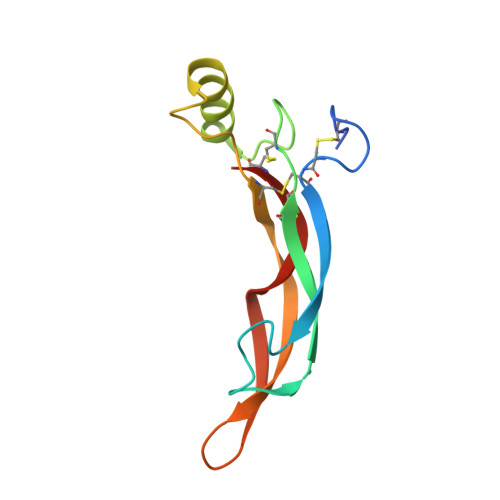Long-acting MIC-1/GDF15 molecules to treat obesity: Evidence from mice to monkeys.
Xiong, Y., Walker, K., Min, X., Hale, C., Tran, T., Komorowski, R., Yang, J., Davda, J., Nuanmanee, N., Kemp, D., Wang, X., Liu, H., Miller, S., Lee, K.J., Wang, Z., Veniant, M.M.(2017) Sci Transl Med 9
- PubMed: 29046435
- DOI: https://doi.org/10.1126/scitranslmed.aan8732
- Primary Citation of Related Structures:
5VT2 - PubMed Abstract:
In search of metabolically regulated secreted proteins, we conducted a microarray study comparing gene expression in major metabolic tissues of fed and fasted ob/ob mice and C57BL/6 mice. The array used in this study included probes for ~4000 genes annotated as potential secreted proteins. Circulating macrophage inhibitory cytokine 1 (MIC-1)/growth differentiation factor 15 (GDF15) concentrations were increased in obese mice, rats, and humans in comparison to age-matched lean controls. Adeno-associated virus-mediated overexpression of GDF15 and recombinant GDF15 treatments reduced food intake and body weight and improved metabolic profiles in various metabolic disease models in mice, rats, and obese cynomolgus monkeys. Analysis of the GDF15 crystal structure suggested that the protein is not suitable for conventional Fc fusion at the carboxyl terminus of the protein. Thus, we used a structure-guided approach to design and successfully generate several Fc fusion molecules with extended half-life and potent efficacy. Furthermore, we discovered that GDF15 delayed gastric emptying, changed food preference, and activated area postrema neurons, confirming a role for GDF15 in the gut-brain axis responsible for the regulation of body energy intake. Our work provides evidence that GDF15 Fc fusion proteins could be potential therapeutic agents for the treatment of obesity and related comorbidities.
- Department of Cardiometabolic Disorders, Amgen Inc., 1120 Veterans Boulevard, South San Francisco, CA 94080, USA.
Organizational Affiliation:

















